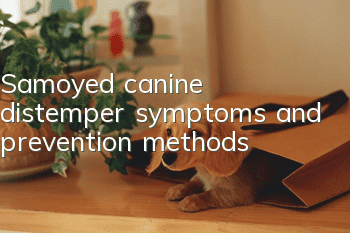Samoyed canine distemper symptoms and prevention methods

Symptoms of canine distemper in Samoyed:
1. Once a Samoyed gets canine distemper, the initial body temperature will start to rise (up to 40℃), but it will continue to It returns to normal after 1 to 2 days. At this time, the owner may think that the dog just has a slight cold and not pay too much attention to it.
2. When the Samoyed's body temperature continues to rise in the middle period, a few cases die at this time, with red and yellow urine, sticky or purulent secretions from both eyes, poor mental health, and anorexia, but still have appetite.
3. Slowly, the canine distemper virus will begin to invade the respiratory system. The dog will show an increase in body temperature, eye discharge, serous to purulent nasal fluid, cough, accelerated breathing, and rales on auscultation of the lungs. Waiting for pneumonia symptoms, respiratory symptoms appeared at this time, the sick dog's eyelids were swollen, and purulent conjunctivitis occurred.
4. Samoyeds often develop corneal ulcers in the later stages of the disease; there are rice-grained red spots, edema and purulent papules on the skin of the lower abdomen and medial thighs; dogs often vomit, constipation, diarrhea, and feces. Foul smell, sometimes
5. In the late stage of canine distemper, Samoyeds will also have neurological symptoms, such as opening and closing the mouth, or rhythmic shaking of the corners of the mouth, head muscles, or one, two or four legs. Epilepsy, convulsive intermittent seizures, involuntary continuous smacking of the lips, foaming at the mouth or blood in the saliva, incontinence of urine and feces, excitement and restlessness at the end of the convulsions, blind running, and finally general weakness, lying on the ground to rest.
Methods to prevent canine distemper:
1. The best way is to regularly immunize and vaccinate against canine distemper.
2. Avoid going to places where dogs are densely populated to avoid an outbreak of canine disease and infection.
3. The home must be disinfected regularly. It is best for the owner to disinfect the dog in time when returning home from outside. If other dogs at home are sick, they must be isolated and disinfected immediately.
4. Once a dog is found to have symptoms, the sooner it is treated, the greater the success rate of treatment. The symptoms of canine distemper are complicated, and the cure rate is not high. Don’t miss the best treatment time by trying it yourself.
- Is it normal for a golden retriever’s tongue to be red? Is there any disease?
- How to teach a golden retriever that it can’t bark? The best golden retriever training method!
- How to train a golden retriever not to move? What should you pay attention to?
- How to effectively remove the odor on your dog’s body?
- How often should Satsuma hair be trimmed? How should Satsuma hair be trimmed?
- What to do if your dog’s ears get watery
- What are the symptoms of dog tapeworms?
- How to take care of a lactating dog
- Can a female dog take a bath immediately after giving birth?
- How to train your dog to refuse food from strangers



